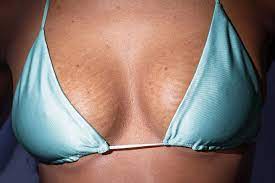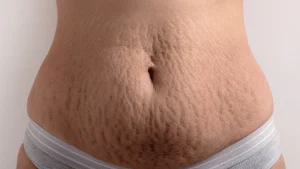
Do You have Stretch Marks On Your Breasts? Important Tips To Understand The Cause and Treatment
Stretch marks can appear anywhere on your body, including your breasts. If you want to reduce the appearance of stretch marks on your breasts, try some methods that may help.
Stretch marks are annoying lines that can appear on various parts of the body. Stretch marks on the breast are caused by many things, including pregnancy, rapid growth, and weight change. They occur when the elastin fibers that make up the skin’s collagen stretch, causing scar-like marks. Although they are harmless and often fade over time, many people seek medical treatment to reduce their appearance. It is important to first understand the truth about breast stretch marks before deciding on treatment.
What are stretch marks?
Stretch marks are discolored scars that form when the skin is stretched or contracted rapidly. According to research published by StatsPearls, they are most common on the abdomen, hips, thighs, back, chest and groin areas. This change can cause collagen and elastin to break down, which encourages the skin to break down. Stretch marks will appear as the skin heals. They often occur during periods of rapid growth, such as puberty, pregnancy, or weight change.
“When the breast skin expands or shrinks rapidly, the collagen and elastin fibers in the dermis will be damaged due to pressure from the fat base or muscles. This damage can lead to the formation of stretch marks,” explains dermatologist Dr. Sujata Dora. These scars occur because the skin cannot adapt quickly to the changes, causing the support structure to collapse.

Causes of stretch marks on breasts
According to research published by StatsPearls, there are many reasons why stretchmarks appear on breasts.
1. Puberty
Hormonal changes during puberty cause breast tissue to expand. As the tissue grows, so does the skin. The thinning of the breast skin can cause stretch marks. Some people may notice stretch marks on their hips, buttocks, and thighs.
2. Pregnancy
Pregnancy is another cause of breast enlargement. Breasts begin to grow after six weeks of pregnancy, when more estrogen stimulates breast development and breast growth. Some people’s breasts will grow up to two cups. This rapid expansion can lead to stretchmarks.
3. Weight gain or loss
Large breasts are often seen in overweight women. Therefore, when the breast grows, stretch marks will appear. Although the fatty tissue decreases when you lose weight, the marks on your breasts do not disappear. This is due to the loss of collagen after losing weight, which causes the skin to become softer.
How to prevent stretch marks on breasts
Stretch marks appear as scars on the breasts. – These marks usually start out red, purple or dark brown and become lighter in color over time. They can grow a little and they can itch. Here are some ways to prevent stretch marks:
- Drinking 8 to 10 glasses of water a day can help restore skin elasticity, make it smooth and supple, and thus prevent stretch marks.
- Exfoliate and moisturize your skin regularly.
- Include foods rich in vitamin C, such as berries, raw cabbages, citrus fruits, kiwi, melon, peas, peppers, broccoli, pineapple, spinach, tomatoes, and radishes in your daily intake to help kill toxins and free radicals.
- Foods rich in omega-3 fatty acids, such as walnuts, flaxseed, chia seeds, salmon, and broccoli, will help prevent stretch marks.
Home remedies to treat stretch marks
Here are some simple and effective ways to reduce stretchmarks, recommended by experts.
1. Aloe vera gel
Aloe vera has antibacterial properties. This can be used to heal stretch marks. A study published in the Journal of Maternal-Fetal and Neonatal Medicine showed that using aloe vera gel for stretch marks can reduce itching and prevent its spread.
How to use:
Remove the outer layer of the aloe vera leaf and scoop out the sticky gel inside.
After applying the gel by massaging it into the skin, leave it for 20 to 40 minutes.
Rinse with water.
2. Olive Oil
Olive oil has good moisturizing properties. According to research published in the Indian Journal of Dermatology Online, it is rich in minerals and antioxidants and is especially helpful in healing skin damage such as itching and preventing stretch marks.
How to use:
Applying 2-3 teaspoons of cold-pressed olive oil to the affected areas of the breasts will help reduce stretch marks over time.
3. Coconut oil
According to research published in the Indian Journal of Dermatology Online, Coconut oil can moisturize the skin and reduce stretch marks. Coconut oil can also prevent the breakdown of skin collagen and the appearance of stretch marks.
How to use:
Pour 2-3 teaspoons of coconut oil into a bowl.
Gently massage the coconut oil into the affected area of the breast until the oil melts into the skin.
Most home remedies for stretch marks are usually painless. However, they can cause the skin to dry, flake, or peel. It is recommended to do a patch test and stop using it if side effects occur. It is also important to consult your doctor before trying any home remedies.

Chemical treatments for stretch marks on breasts
Here are some simple treatments to remove scars from your breasts, according to the American Academy of Dermatology. But you should only use these treatments after consulting your dermatologist:
- Retinoids and over-the-counter creams containing glycolic acid or vitamin C can stimulate collagen production and improve skin texture.
- Laser therapy targets damaged skin, stimulating collagen production and reducing the appearance of stretch marks.
- Microdermabrasion is a method of exfoliating the top layer of skin to improve texture and tone.
- Exfoliating the skin using a peel can help reduce the appearance of stretch marks.
- Consulting a dermatologist is crucial to determining the best treatment for your unique skin condition and needs.

